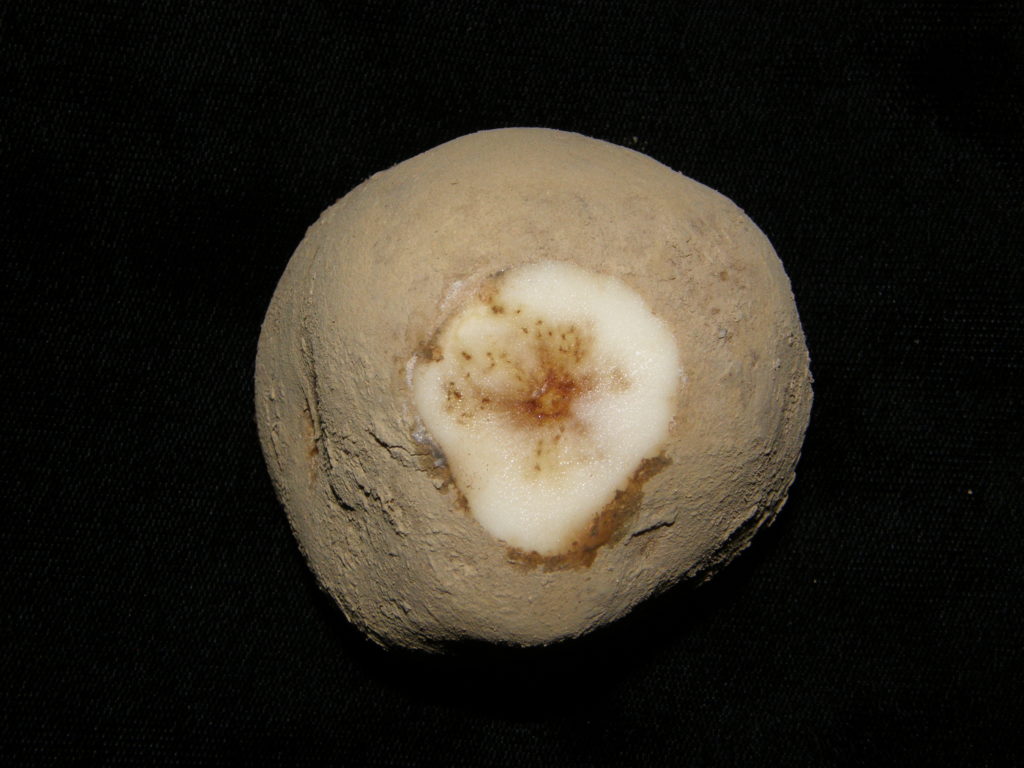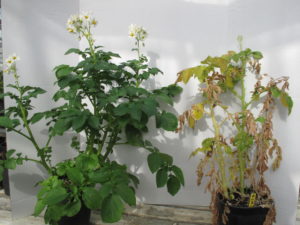
Verticillium wilt a ‘complicated knot to untie’ for potato growers
Found in all potato growing regions in the United States, verticillium wilt is a serious disease that diminishes quality and causes significant yield loss by reducing tuber size. While researchers continue to look for new mitigation strategies, prevention remains the best method of control for this potentially serious disease.
Potato growers have two tools for dealing with verticillium wilt. Typically, the go-to solution has been fumigation, said David Wheeler, plant pathologist, Washington State University. Other growers have gone the resistance route. However, even though there are varieties that convey some level of resistance, they’re not a good choice for many growers.
“A lot of time they don’t possess the horticultural traits that growers desire, so they’re just not planted at scale,” explained Wheeler.
While fumigation and resistance remain growers’ best options, researchers hope to provide better mitigation strategies in the future. For example, ongoing research is looking at modifying the growing environment to mitigate or suppress verticillium, said Wheeler.
“For example, green manure research has been ongoing for decades,” he said. “Unfortunately, it’s not in a place right now where it’s very conclusive.”
One of the challenging aspects of the disease is that it is extremely variable, which makes it difficult for extension specialists to offer concrete advice when it comes to management. Severity depends on the type and amount of verticillium in the soil, as well as other factors, including weather and fertility.

Some strains are aggressive or virulent toward potatoes, while others are not. In potato, verticillium wilt is caused by one of two strains: Verticillium dahliae or Verticillium albo-atrum. Of the two, Verticillium dahliae is the more destructive. Both survive in the soil and in infected plant debris. Verticillium dahliae overwinters in the soil and has been reported to remain as long as seven years without a host crop.
What makes verticillium even trickier is that pathogen load doesn’t seem to impact disease severity. It’s possible to have a lot of verticillium in a field, but very few issues. Conversely, very little verticillium can become a severe issue.
“It’s a very complicated knot to untie,” said Wheeler.
Soil variances and effect
Pathogen load isn’t the only wild card when it comes to disease outbreak. In some cases, microbes present in the soil suppress the verticillium. In others, both fertility and weather can play a role. When soil moisture is high, the pathogen grows and spreads quite quickly, but when soil moisture levels are low, wilt can be more severe. Where soil fertility is low, wilt may be even more severe. High nitrogen rates tend to delay the onset of symptoms.
Interestingly, Wheeler said farmers growing potatoes in soils that have never been exposed to potatoes before report a 14-20% yield boost in some cases. Researchers working to better understand the impact of “virgin soils” on potato health. Their first aim is to verify the claims. To do so, they are conducting a “common garden experiment,” where they grow potatoes in small plots using soil that has never been exposed to potatoes and soil that has been exposed to potatoes. They plan to characterize the soil by quantifying all of the microbes present in both soil types.
“We expect to see the potatoes grown in the virgin soil perform better,” said Wheeler, who is the principal investigator on the project. He is working in collaboration with soil scientists and pathologists. Using DNA sequence data, the aim is to identify fungi, bacteria and nematodes present in the soil.
“We hope that the yields are higher and disease intensity is lower,” he said. “If it does work, if we do see that effect, then we’ll try to reproduce it at scale by maybe finding some of the microbes that are very associated with the virgin soil and perhaps trying to inoculate them into soils that are not virgin, for example.”
But the process is very complicated and there are many factors that impact the disease.
Wheeler is also part of a project that is working to identify the verticillium genes that are associated with disease in potatoes, as well as infection in asymptomatic crops like mustard.
“The reason why that might matter is that if we can find genes that are associated with genes in potato, we can give those data to breeders and they can help develop resistance,” said Wheeler.
Developing resistance
In the future, the hope is that geneticists are able to convey resistance via RNA interference using gene-editing technology.
“The advantage of that would be that we wouldn’t have to apply fungicides if it worked,” said Wheeler. “That would be awesome. But we have to convince consumers that it’s safe, and that’s a very big hurdle.”
In the meantime, Steven Johnson, Extension Crops Specialist, University of Maine, said the best course of action is still prevention. Avoid introducing the pathogen to uninfected fields, including via dirty equipment, and use clean, high quality seed, he said.
For those farmers whose fields already have verticillium wilt, rotation is the best long-term solution. The success of this management strategy was particularly evident this past growing season when most of Maine’s potato farmers faced severe drought.
“When there’s a drought, verticillium wilt comes on faster, it’s more exacerbated and a plant that could probably handle a low level of verticillium and not show a significant symptom shows it now because the vascular system is so stressed it doesn’t take much plugging with the pathogen,” said Johnson.
“The people who had longer rotations… it was very noticeable,” he added.
A three-year rotation is best, advised Johnson. And while that wouldn’t be long enough in other states, Maine experiences long, cold winters, which helps reduce pathogen load come spring.
“But the real bottom line here is that extended rotation did show a lot of value,” Johnson concluded.







